The impact of cadence on running economy

In our book (www.thesecretofrunning.com) we have described our initial treadmill research on 14 test runners in the physiological laboratory of the Dutch Sports Medical Center SMA Midden Nederland. We were quite impressed by the results which showed that the Stryd power data closely correlated to the VO2, which has always been considered as the gold standard in physiological research.
Recently, we have carried out a new research project in cooperation with the physiological laboratory of prof. Maria Hopman at the Radboud University of Nijmegen (RUN), the Netherlands. A full scientific paper on the project has been submitted to the Journal of Sports Sciences and Medicine. In order to share our results with the running community at large, we have written 4 short popular papers (numbered 24-27) on the main findings:
1. The (close) relationship between Stryd power and VO2
2. The impact of speed on the running economy (ECOR and RE)
3. The impact of cadence on the running economy (ECOR and RE)
4. The physiological differences between trained and untrained runners
This paper is the third of this series. The pictures below show the authors during the treadmill tests as well as some of the laboratory equipment at RUN. The left picture also shows the primary investigator, MSc-student Rick Sniekers.
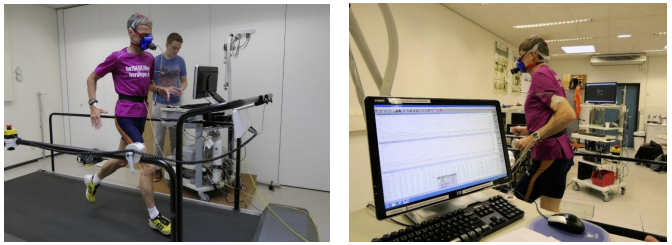
Trained runners need both less power as well as less oxygen than untrained runners
The project included measuring the VO2 (in ml O2/kg/min) and Stryd power (in Watt/kg) of 21 runners (11 trained and experienced distance runners and 10 untrained students) at a moderate speed (lactate threshold minus 2 km/h). All runners first ran for 3 minutes at their self-selected cadence, followed by 3 minutes at a 10 steps per minute higher cadence (the runners were assisted in doing this by a metronome) and finally 3 minutes at a 10 spm lower cadence. This means that we got a total of 21*3 = 63 data of VO2 and power.
From the power data, we calculated the Energy Cost of Running (ECOR) with the formula:
ECOR (kJ/kg/km) = P (Watt/kg)/v (m/s)
As an example we use a P of 3.4 Watt/kg and a speed of 12 km/h (3.33 m/s), so the ECOR is 3.5/3.33 = 1.02 kJ/kg/km.
From the VO2 data we calculated the oxygen cost of running, commonly referred to as the Running Economy (RE) with the formula:
RE (ml O2/kg/km) = 60/3.6*VO2 (ml O2/kg/min)/v (m/s)
As an example we use a VO2 of 45 and a speed of 12 km/h (3.33 m/s), so the RE is 60/3.6*45/3.3= 225 ml O2/kg/km.
We have summarized the results for the two groups and the different speeds in the table below. One of the most striking findings is that trained runners were consistently more economical than untrained runners, both in terms of the mechanical energy that they needed for running (ECOR) as well as the amount of oxygen that they used (RE). The average RE of untrained runners was 248 ml O2/kg/km which was 7% higher than the average for trained runners (231 ml O2/kg/km). The average ECOR of untrained runners was 1.05, which was 5% higher than the average for the trained runners (1.00 kJ/kg/km). This means that we conclude that training results in 2 important benefits:
1. The running technique improves, which leads to a 5% lower ECOR
2. The metabolic efficiency improves, which leads to an even greater reduction of the RE to some 7%
In the earlier paper (#24), we already noted that the ME of our trained runners was higher than that of the untrained runners (24% vs 23% or a relative increase of 4%). This explains the discrepancy between the 7% difference in RE as compared to the 5% difference in ECOR of the two groups.


ECOR declines consistently with cadence, RE is usually best at the self-selected cadence
We have prepared the 4 figures below to illustrate this effect. Next to the big difference between untrained and trained runners, they show the impact of cadence on running economy.
As cadence increases, the ECOR reduces slightly but consistently. For trained runners the reduction is 3%, for untrained runners it is bigger (6%). The reduction of ECOR is probably related to the reduction in vertical oscillation, that occurs simultaneously when cadence is increased at the same speed.
Regarding RE, the impact is less consistent. A lower cadence always leads to an increase in RE, but a higher cadence usually does not. It seems that regarding RE the self-selected cadence is usually the best. This complies with earlier reports in literature, where other researchers have also found that the self-selected cadence is best in terms of oxygen use and RE.
We found this discrepancy between the response of ECOR and RE to changes in cadence quite difficult to understand. It seems that the only logical explanation for this could be that the metabolic efficiency (ME) does not remain constant when the cadence changes. In our book, we have derived the following relationship:
ME = Mechanical power/ Metabolic power = 1000*ECOR/(RE*EY)
The EY is the energy yield of oxygen which can be approximated at 19 J/ml O2. As an example, we use an ECOR of 1.0, an EY of 19.0 and an RE of 225, so the result is an ME of 0.23 or 23%. As we saw above, at an increased cadence the ECOR declines by some 3-6%, so the ME should also decline by the same percentage. It puzzles us why this should occur. Some authors have stated that due to many years of walking and running, the human body has habituated itself to the self-selected cadence, which might explain that the ME is optimal at the self-selected cadence.
The correlation between the data is quite impressive and even more so when we realize that the data points represent a heterogeneous set of runners and test conditions. This confirms our earlier findings that the daily Stryd ECOR data can be used very well to optimize training and running technique and economy. However, regarding the impact of cadence, we feel that we need to be cautious. Apparently, the human body is quite habituated to the self-selected cadence, so it may take a long time to change this through training and to see the full impact on the long run. The ECOR data seem to indicate that runners should aim to increase their cadence, but the current data do not warrant a conclusion that this will reduce the RE as well.
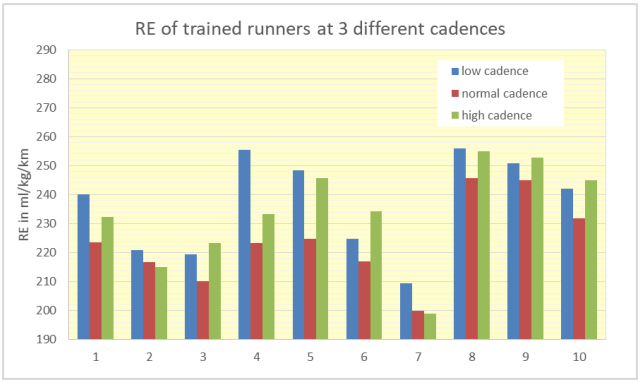
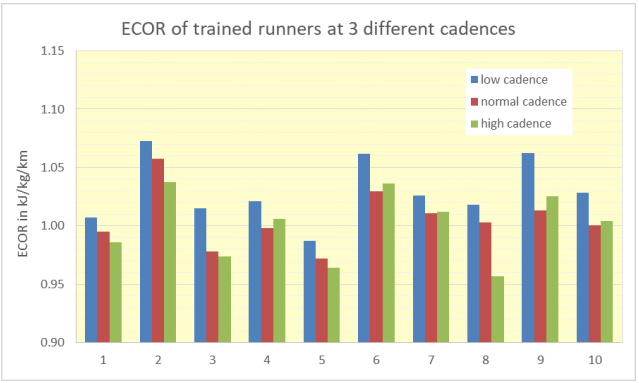
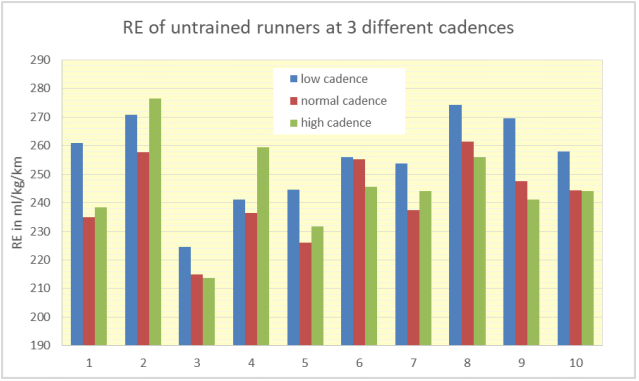
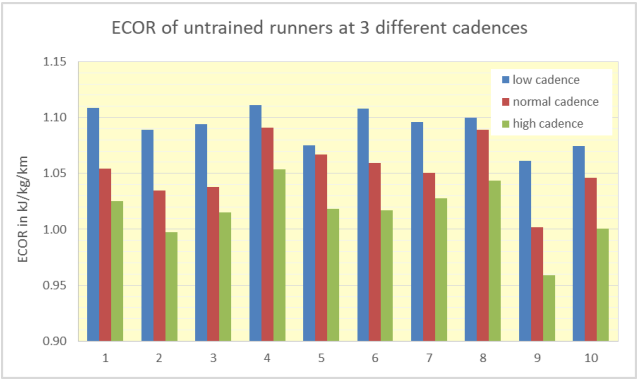
Conclusions
Also in this research, we found a significant and consistent difference between the trained runners and the untrained runners. The results of the trained runners were superior in various aspects:
1. They needed on average 5% less mechanical energy (ECOR 1.00 vs 1.05 kJ/kg/km)
2. They needed on average 7% less oxygen (RE 231 vs 248 mlO2/kg/km)
3. Their metabolic efficiency (ME) was on average 4% higher (24% vs 23%)
The impact of cadence on ECOR and RE was more puzzling:
1. ECOR decreases slightly with cadence (by some 3-6%)
2. RE is usually best (minimal) at the self-selected cadence
The results confirm our earlier findings that the Stryd power data and in particular the ECOR can be used very well to optimize training and running technique on a daily basis. Improvements in training should lead to both lower energy cost (ECOR) as well as oxygen cost (RE) of running at a certain speed. However, regarding the impact of cadence, we feel that we need to be cautious. Apparently, the human body is quite habituated to the self-selected cadence, so it may take a long time to change it and see the full impact on the long run. The ECOR data seem to indicate that runners should aim to increase their cadence, but the current data do not warrant a conclusion that this will reduce the RE as well.
If you would like to purchase The Secret of Running (or the German version, Das Geheimnis des Laufens), you can do so at the bottom of store.stryd.com.

